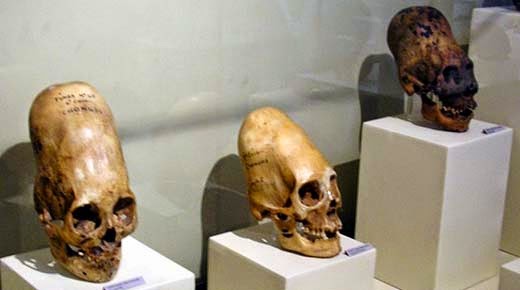
On the southern coast of Peru lies the desert peninsula of Paracas. This barren landscape is where Peruvian archaeologist Julio Tello made an astounding discovery in 1928. His efforts uncovered a massive and complex graveyard buried under the sand and rocks.
In these tombs Tello found some of the most controversial human(?) remains in history. The bodies had the largest elongated skulls in the world and have since been called the Paracas skulls. Tello found a total of more than 300 skulls and they have been dated at around 3,000 years old. A recent DNA analysis performed on some of those skulls has presented amazing results that could challenge the current perspective of the human evolutionary tree.
Several other cultures have practiced skull elongation or deformation but the techniques they used produced different results. Certain South American tribes used to bind infants’ skulls in order to change their shape. Binding the head between pieces of wood modified the appearance of skulls by applying constant pressure over a long period of time. This type of cranial deformation changed the shape but it did not alter the size, weight or cranial volume; these are all standard characteristics of a regular human skull.

The Paracas skulls are different. Their craniums are 25% larger and 60% heavier than regular human skulls which led researchers to believe they couldn’t have been modified through binding. They are also structurally different and only have one parietal plate as opposed to the two normally found in human skulls. These differences have deepened the decade-old mystery around the Paracas skulls and researchers haven’t been able to explain their origins.
The director of the Paracas History Museum has sent samples from 5 skulls to undergo genetic testing. The samples consisted of hair, skin, teeth and fragments of skull bones. The genetic laboratory was not informed about the samples’ origins in order to avoid biased or influenced results. The results were fascinating.
The mitochondrial DNA (inherited from the mother) presented mutations unknown to any man, primate or any other animal. The mutations suggested we are dealing with a completely new human-like being, very distant from Homo sapiens, Neanderthals or Denisovans. The Paracas individuals were so biologically different from humans they wouldn’t have been able to interbreed. “I am not sure it will even fit into the known evolutionary tree”, one geneticist added.
The implications of this discovery are huge. Who were the mysterious Paracas people? Did they evolve here on Earth on a path so different from us that they ended up looking drastically different? If not, where did they come from? Are any of them left?
This breakthrough brings up more questions than it answers but counts as another piece of evidence suggesting that we are not alone.



















0 comments:
Post a Comment